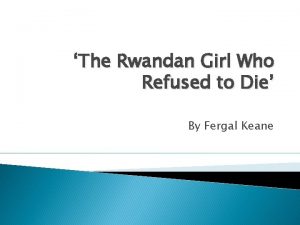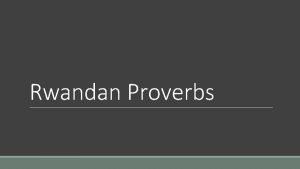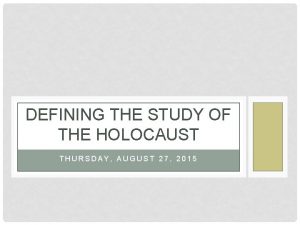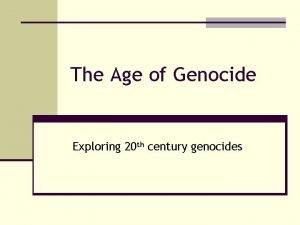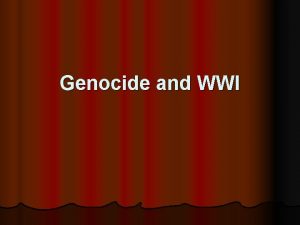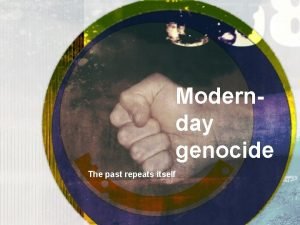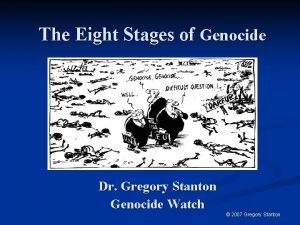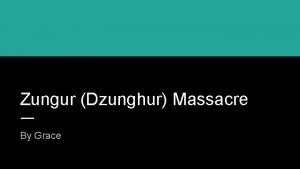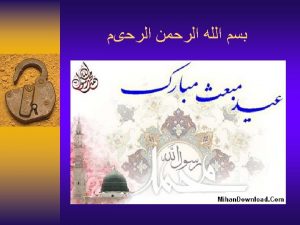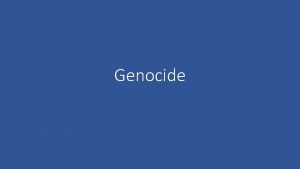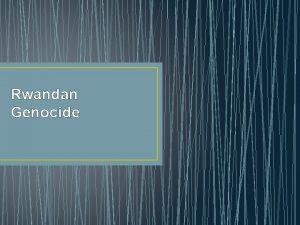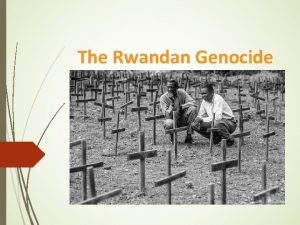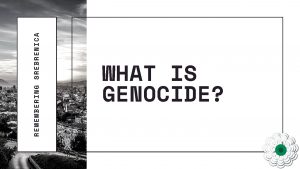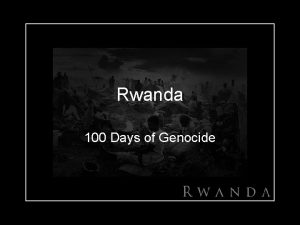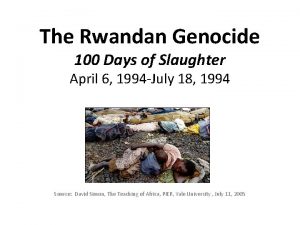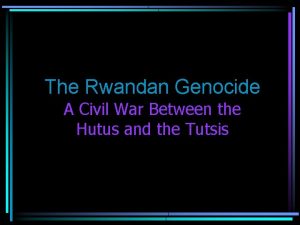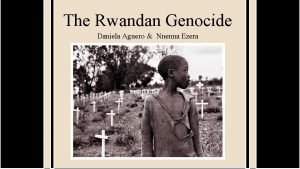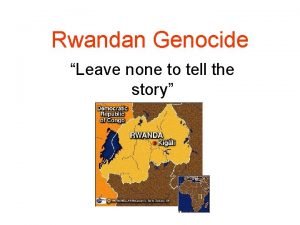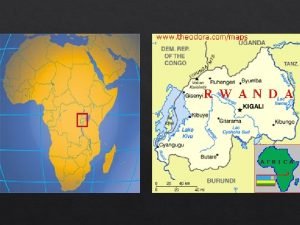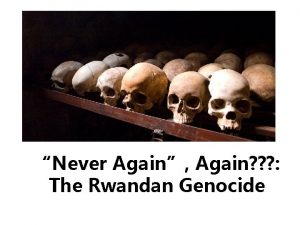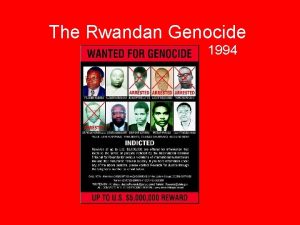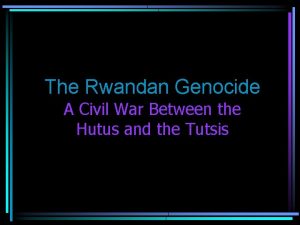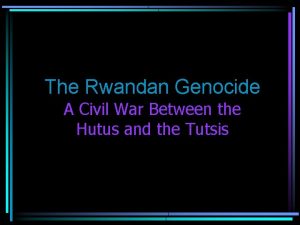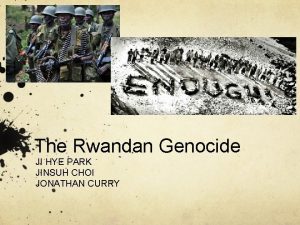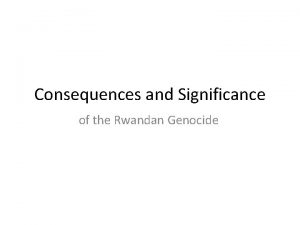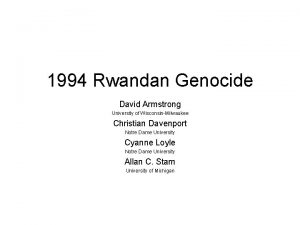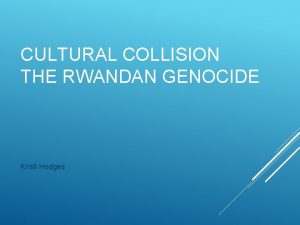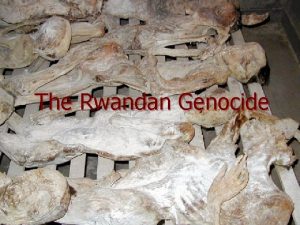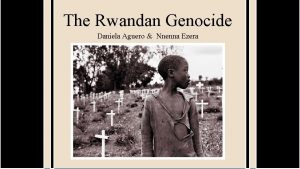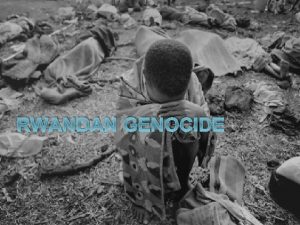The Rwandan Genocide Genocide Genocide is a term


























- Slides: 26

The Rwandan Genocide

Genocide • Genocide is a term defined as any act committed with intent to destroy, in whole or in part, a national, ethnic, racial or religious group, as such: – Killing members of the group – Imposing measures intended to prevent births within a group

Rwanda Genocide • The Rwandan genocide was the systematic massacre of an estimated 800, 000 people – Mostly Tutsi tribe members – Also includes moderate Hutus members • The massacre lasted approximately 100 days from April to mid-July, 1994


Rwanda-History • 3 tribes of people that inhabit Rwanda – Twa • The original inhabitants – Hutus • Migrated in 1000 s – Tutsi • Migrated in the 13001400 s

Rwanda-History (Continued) • The Tutsis tribe of people gained a large dominance over the Hutus • By the late 18 th century, a single Tutsi-ruled state occupied most of the present day Rwanda – Controlled by a Tutsi King who controlled the land – Gave power to the Tutsi people • Population did not mean control: – 75% Hutu – 20% Tutsi – 5% Twa

Rwanda 1890 • In 1890, Rwanda accepted German rule without resistance – Became part of the German East Africa • Germany – Little rule over Rwanda – No economic development • Tutsis still ruled the country

Rwanda 1916 -1919 • During WW 1 (1916), Belgian forces occupied Rwanda • In 1919 it became part of the Belgian League of Nations • Social structure was not altered • Christian missionary work of converting the locals to Roman Catholicism was undertaken

Rwanda 1933 • Belgian control of Rwanda – Political power rested with the Tutsis • Eugenics movement – Tutsis were considered to have Caucasian ancestry • Thought to have lighter skin & larger skulls • Tutsis were ‘superior’ to Hutus

Rwanda 1933 (continued) • One of the major contributing factors to the split of ethnic groups was the creation of group classification on ID cards in 1933 – Introduced a rigid racial concept of group identity

Rwanda 1933 -1956 • Tutsis began to believe the myth of their superior racial status • Tutsis exploited their power over the Hutu • Created a resentment and hostility between the Tutsis & Hutu

Rwanda 1959 • Civil war erupted in 1959 – Fighting between the Hutus and Tutsis – The Hutus emerged victorious – Tens of thousands of Tutsis were killed – Around 100, 000 Tutsis fled the country

Rwanda 1960 s-1970 s • Series of Hutu-Tutsi clashes • Government was controlled by the military • 1973 – Defense Minister Juvénal Habyarimana (Hutu) took over the government – Re-elected several times as leader until 1993

Rwanda 1990 -1993 • In 1990, Rwanda was invaded from Uganda by the Rwandan Patriotic Front (RPF) – Mainly Tutsi refugees – The invasion was unsuccessful – President of Rwanda agreed to share the power • In 1993, a power-sharing agreement was signed between Hutus and Tutsis

Rwanda 1994 • In April 1994, the president of Rwanda and the president of Burundi were killed in a suspicious plane crash • Civil strife erupted on a massive scale • Rwandan soldiers and Hutu gangs slaughtered an estimated 800, 000 people, mostly Tutsis and moderate Hutus

Rwandan Statistics • An estimated 800, 000 people were killed of a population of about 7 million • No outside government did anything to stop the genocide • The weapon of choice was the machete – Also used nail-studded clubs, and guns

Rwandan Horror • Not Just Killed – Many of the women and girls were violently sexually assaulted by HIV+ men as part of a systematic rape campaign

Images

Images

Rwanda Today • Rwanda is struggling to heal and rebuild • It is showing signs of rapid development • The major markets for exports are: – Belgium, Germany, and China

Rwanda Today • In April 2007 – Investment and trade agreement with Belgium • Many Hutu people have returned to Rwanda • The government has promoted reconciliation and economic development

THE END


Assignment Rwanda Jigsaw • Break up into groups of 5 • Each group will be given a topic • The groups will then create a report of events (using a variety of visual aids) for the topic • Students will then break up into new groups and present their data to their new group

Rwanda Jigsaw Topics • A report on the response from the rest of the world to the situation in Rwanda from 1994 to now • A report on the steps taken by Rwanda to prevent a genocide from ever happening again • A report on the steps taken/not taken in regards to the conflict in Darfur-relate what is happening in Darfur to the events in Rwanda • A report on the changes in regards to women in Rwanda and how their roles in society have changed since 1994 • A report on how Rwanda will look in 2044 (50 years after the genocide). This timeline will describe how the country has reconciled with its past based on how far they have come to date. Use other examples (Germany) as models of how to overcome such tragedies

Resources • http: //en. wikipedia. org/wiki/Genocide • http: //news. bbc. co. uk/2/hi/africa/1288230. stm • http: //en. wikipedia. org/wiki/Rwanda_genocide
 The rwandan girl who refused to die
The rwandan girl who refused to die Wise in kinyarwanda
Wise in kinyarwanda Long-term liabilities examples
Long-term liabilities examples Short medium and long term planning in education
Short medium and long term planning in education Long term goals examples
Long term goals examples Short term and long term human resource planning
Short term and long term human resource planning Minterm and maxterm
Minterm and maxterm Term-to-term rule
Term-to-term rule Research paper on financial planning and forecasting
Research paper on financial planning and forecasting Term-to-term rule
Term-to-term rule Rules in finding the nth term
Rules in finding the nth term Long term memory vs short term memory
Long term memory vs short term memory Difference between long term and short term liabilities
Difference between long term and short term liabilities Term to term rule
Term to term rule Quadratic sequences
Quadratic sequences Cambodian genocide classification
Cambodian genocide classification What does peter drost define genocide as?
What does peter drost define genocide as? Lenin genocide
Lenin genocide Genocide definition
Genocide definition Genocide
Genocide Define genocide
Define genocide Past tense of genocide
Past tense of genocide The eight stages of genocide
The eight stages of genocide Zunghar genocide
Zunghar genocide Barotrauma genocide
Barotrauma genocide The deliberate killing of a large group of people
The deliberate killing of a large group of people Declares killings genocide
Declares killings genocide
